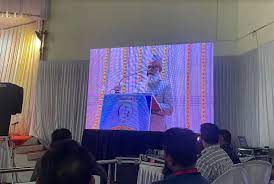Malegaon (Nashik District), MAHARASHTRA:
Dr Razi was speaking at the two-day International Conference on Scientific Exploration and Understanding of Tibb e Nabvi organised by Mohammadia Tibbia College and Assayer Hospital at Mansoora in Malegaon Monday December 11, 2023.

Mansoora (Malegaon):
Tibb e Nabawi is not a complete medical system though Prophet Muhammed (Peace be upon him) through his teachings laid the foundation for the later stage research in the healthcare system, experts said while addressing an International Conference titled “Scientific Exploration and Understanding of Tibb e Nabavi” in Malegaon Monday December 11, 2023.
“The notion that Tibb e Nabawi is a complete medical system which is sufficient to cure every disease is wrong. But, it is true that Prophet Muhammad (peace be upon him) through his teachings highlighted the importance of a healthy society that laid the foundation of future research in healthcare”, Dr Razi ul Islam Nadvi said.
“The Philosophy of Tibb e Nabawi”
Dr Mohammad Raziul Islam Nadvi – a postgraduate in Unani Medicines, is Islamic Scholar, Writer, Translator and an active member of Jamat-e-Islami Hind.
“The Prophet’s idea of healthcare and medical practice were akin to the art that require perfectness and mastery. There are umpteen number of examples when the Prophet (pbuh) during his lifetime encouraged his companions to opt for a skilful tabeeb (doctor) and better medical treatment”, he said.
“The famous Hadith of the Prophet which goes “there is cure for every disease” if not taken at its face value but properly understood encourages A’tibba (pleural of tabeeb meaning doctors) and medical practitioners to continue their research till they succeed”, he said.
Dr Razi was speaking at the two-day International Conference on Scientific Exploration and Understanding of Tibb e Nabvi organised by Mohammadia Tibbia College and Assayer Hospital at Mansoora in Malegaon Monday December 11, 2023.
The first of its kind Tibbe Nabawi conference is attended by doctors, health experts and scholars from India and abroad.
“Contribution of Muslim women in healthcare”
Dr Razi said the Prophet’s message was not limited to male companions but also for the females.
“Hadhrat Rufayda al-Aslamia was used to maintain a hospital during the Prophet’s lifetime. She trained a number of female companions in nursing who used to assist those who are sick or injured in the battlefields”, Dr Razi said.
Rufayda Al-Aslamia (also transliterated Rufaida Al-Aslamiya or Rufaydah bint Sa`ad), believed to be the first female surgeon in Islam, was among the first in Madinah al Munawwarah to embrace Islam. With her clinical skills, she trained other women, including the wife of the Prophet (pbuh) Ayesha, to be nurses and to work in the area of health care.
“This also shows the contribution of Muslim women in the field of medicine and healthcare”, he said.
Dr Razi ul Islam said it was because of the teachings of the Prophet (pbuh) that laid the foundation of healthcare research, Muslims translated the ancient Unani or Greek books on medicines.
“Not only did the Muslims translate these books into Arabic but they also compiled them maintaining unbelievable professionalism”, he said.
“Characteristics of Tibbe Nabawi”
The concept of Tahaarat – purity and cleanliness and hygiene, is one of the key characteristics of Tibb e Nabvi, and the Prophet (pbuh) introduced it at a time when people were unaware of such things.
“By highlighting the importance of a hygienic society, the Prophet’s message clearly was ‘prevention is better than cure’”, Dr Razi said.
“Quarantine was the word which recently became famous during the Covid-19 Pandemic. But it was in practice during the lifetime of Prophet Muhammad (pbuh) and afterwards”, he said.
The other characteristic of Tibb e Nabavi is ethics in medical practice and healthcare system that the Prophet (pbuh) asked his companions to strictly follow.
“Various clauses of the Hippocratic Oath – the oath of ethics historically taken by physicians, can easily be found in the teachings of the Prophet (pbuh)”, Dr Razi ul Islam said.
“Need of Research on Tibb e Nabawi Based on Scientific Parameters”
Dr Razi further said there is a need of research on the subject based on scientific parameters to make Tibb e Nabawi beneficial for people across the board.
“A tremendous amount of work on Tibb e Nabwi has been done and is still underway around the world especially in the Arab world. However, the focus of these research works is more on Aqeedat and done out of the love and affection to Prophet Muhammed (PBUH)”, Dr Razi said.
“If we want to make Tibbe Nabavi acceptable for people across the board then we have to scientifically prove and establish its effectiveness”, he said.
“There should be a team of doctors who do research and study on Tibb e Nabawi and come with data based on scientific parameters”, he said.
source: http://www.ummid.com / Ummid.com / Home> Health / by ummid.com news network / December 11th, 2023










